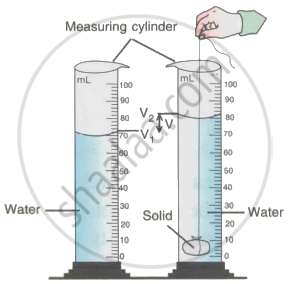Advertisements
Advertisements
Question
Describe an experiment to determine the density of the material of a coin.
Solution
The density of the material of a coin is determined by the following experiment:
- We know density is mass per unit volume. So, first mass of the coin is measured by a common beam balance. Let it be M gram.
- Volume of the coin is measured by a measuring cylinder as shown in the figure given below.
- Take a measuring cylinder and fill it partly with water.
- Note the level of water. Let it be V1 mL.
- Tie the coin with a thread and gently lower the coin inside the measuring cylinder. Take care that no water splashes out.
- Note the level of water again. Let it be V2 mL.
- Find the volume of the coin (V) by subtracting V1 from V2.
V = V2 - V1
Density of coin is calculated by the formula: Density = `"Mass"/"Volume"`
D = `"M"/"V" "g cm"^(-3)`

APPEARS IN
RELATED QUESTIONS
Name the force which makes heavy objects appear light when immersed in a liquid.
A body while floating sinks deeper in a liquid of low density than in a liquid of high density.
A body X sinks in water, but a body Y floats on water. The density of the body X is ......... than the density of body Y.
The weight of a body is more than the buoyant force experienced by it, due to a liquid. The body will
State whether pressure is a scalar or vector?
How does the pressure exerted by thrust depend on the area of surface on which it acts? Explain with a suitable example.
Why is a force needed to keep a block of wood inside water?
Describe an experiment to show that a body immersed in a liquid appears lighter than it really is.
Is thrust a scalar or vector quantity?
Write about buoyant force.
